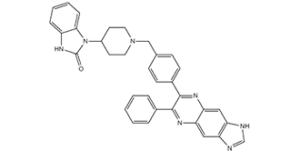Akti-1/2 (AKT inhibitor VIII)
This product is for research use only, not for human use. We do not sell to patients.

For small sizes, please check our retail website as below: www.invivochem.com
| Size | Price | Stock |
|---|---|---|
| 250mg | $750 | Check With Us |
| 500mg | $1350 | Check With Us |
| 1g | $2025 | Check With Us |
Cat #: V0173 CAS #: 612847-09-3 Purity ≥ 98%
Description: Akti-1/2 (known also as AKT inhibitor VIII), a quinoxaline-based compound, is a novel, potent, selective, cell-permeable and allosteric inhibitor of Akt1/2 with potential anticancer activity.
Top Publications Citing Invivochem Products
Publications Citing InvivoChem Products
Product Promise

- Physicochemical and Storage Information
- Protocol
- Related Biological Data
- Stock Solution Preparation
- Quality Control Documentation
| Molecular Weight (MW) | 551.64 |
|---|---|
| Molecular Formula | C34H29N7O |
| CAS No. | 612847-09-3 |
| Storage | -20℃ for 3 years in powder formr |
| -80℃ for 2 years in solvent | |
| Solubility In Vitro | tr |
| DMSO: 22 mg/mL (39.9 mM)r | |
| Water: <1 mg/mLr | |
| Ethanol: <1 mg/mL | |
| SMILES Code | O=C1N(C2CCN(CC3=CC=C(C4=NC5=CC6=C(N=CN6)C=C5N=C4C7=CC=CC=C7)C=C3)CC2)C8=CC=CC=C8N1 |
| Synonyms | Akt-I 1,2; Akti-1/2. Sigma-A6730; AKT inhibitor VIII; AKT-inhibitor-VIII; AKT inhibitor-8; AKT-inhibitor-8; |
| Protocol | In Vitro | When LnCaP cells are pretreated with AKT inhibitor VIII and then incubated with TRAIL, a dramatic increase in caspase-3 activity (6-10-fold relative to control or TRAIL alone) is observed. This sensitization of tumor cell lines with AKT inhibitor VIII is not limited to LnCaP cells as similar apoptosis induction is observed in HT29, MCF7, and A2780 cells, among others, with chemosensitizers such as camptothecin, herceptin, and doxorubicin. |
|---|---|---|
| In Vivo | Mice are dosed with AKT inhibitor VIII (50 mpk, 3 doses, ip, every 90 min) achieving plasma concentrations of 1.5-2.0 μM, and then the animals are tail vein injected with IGF to stimulate Akt phosphorylation. By IP Western, both basal and IGF stimulated Akt1 and Akt2 phosphorylation are inhibited in mouse lung, with no effect on Akt3 phosphorylation. |
These protocols are for reference only. InvivoChem does not
independently validate these methods.
| Solvent volume to be added | Mass (the weight of a compound) | |||
|---|---|---|---|---|
| Mother liquor concentration | 1mg | 5mg | 10mg | 20mg |
| 1mM | 1.8128 mL | 9.0639 mL | 18.1278 mL | 36.2555 mL |
| 5mM | 0.3626 mL | 1.8128 mL | 3.6256 mL | 7.2511 mL |
| 10mM | 0.1813 mL | 0.9064 mL | 1.8128 mL | 3.6256 mL |
| 20mM | 0.0906 mL | 0.4532 mL | 0.9064 mL | 1.8128 mL |
The molarity calculator equation
Mass(g) = Concentration(mol/L) × Volume(L) × Molecular Weight(g/mol)
Mass
=
Concentration
×
Volume
×
Molecular Weight*
The dilution calculator equation
Concentration(start)
×
Volume(start)
=
Concentration(final)
×
Volume(final)
This equation is commonly abbreviated as: C1 V1 = C2 V2
Concentration(start)
C1
×
Volume(start)
V1
=
Concentration(final)
C2
×
Volume(final)
V2
Step One: Enter information below
Dosage mg/kg
Average weight of animals g
Dosing volume per animal µL
Number of animals
Step Two: Enter the in vivo formulation
%DMSO
+
%
+
%Tween 80
+
%ddH2O
Calculation Results:
Working concentration:
mg/ml;
Method for preparing DMSO master liquid:
mg
drug pre-dissolved in
µL
DMSO(Master liquid concentration
mg/mL)
,Please contact us first if the concentration exceeds the DMSO solubility of the batch of drug.
Method for preparing in vivo formulation:
Take
µL
DMSO master liquid, next add
µL
PEG300, mix and clarify, next add
µL
Tween 80,mix and clarify, next add
µL
ddH2O,mix and clarify.
Note:
- (1) Please be sure that the solution is clear before the addition of next solvent. Dissolution methods like vortex, ultrasound or warming and heat may be used to aid dissolving.
- (2) Be sure to add the solvent(s) in order.




































